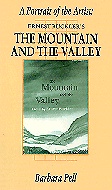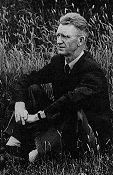

![]()

|
A Portrait of the Artist:
Barbara Pell. Subject Heading:
Professional (senior Language Arts).
***/4.
|
excerpt:
. . . Sociological or historical importance is not enough in itself to warrant reading and studying The Mountain and the Valley as a literary classic. But in its evocation of geography and history, it touches on themes of universal importance. . . . The philosophical concerns that [Buckler] articulates are the twentieth-century themes of alienation, loss, and death; he explores them within the framework of the modernist psychological novel of artistic maturation and isolation.
THE MOUNTAIN AND THE VALLEY (1952) is an early Canadian example of the literary genre a friend once called "Portrait of the Artist as a Tiresome, Self-Absorbed Young Git." (He added that The Mountain and the Valley was somewhat redeemed by killing off its protagonist at the end.) This is probably overly harsh.

But like many mid-century Canadian novels, The Mountain and the Valley does suffer from self-consciousness about writing a Canadian novel, and in this case a Canadian novel about a writer (a more successful, also highly self-conscious example from this period is Hugh MacLennan's Two Solitudes). Buckler, MacLennan, and other mid-century writers paved the way for writers of what we could call Canada's mature period, beginning perhaps with Margaret Laurence, writers comparatively free of the anxiety of being literary pioneers.
Barbara Pell's examination of Buckler's only well known work is part of ECW Press's "Canadian Fiction Studies" series. Pell provides not only reasons why the book still repays attention, but a balanced and comprehensive introduction that will give Language Arts instructors a good entrance to teaching The Mountain and the Valley. Pell, a professor of English at Trinity Western University, considers the various swings of critical opinion and academic thought about Buckler's book, and its central character, with only occasional (and probably unavoidable) lapses into crit-speak, but the bulk of the book is her own analysis, one which is well considered, free of jargon, and essentially correct.
In this "portrait" David Canaan, the failed writer who is the book's protagonist, is tiresome because he is supposed to be. His flaws, his selfishness, his inability to act decisively -- or to realize that even inaction has irreversible consequences -- bring him to his pathetic end. He dies still dreaming (only dreaming) of becoming a great writer who will give voice to the rural Nova Scotia life he can neither escape nor embrace. Meanwhile, his grandmother, practising her rug-making, goes about actually making art from the lives around her with no self-consciousness at all.
Buckler's writing was dense, allusive, and almost as self-conscious as David himself. Pell points out its flaws and virtues, illuminates its structure, and glosses its references.
I remain unconvinced that The Mountain and the Valley belongs on the high-school curriculum, but I wish I'd had Pell for a professor when I was in grad school. For those who are teaching the novel, Pell's book is probably essential; it may even be a useful resource for advanced students, especially if they're armed with a copy of A Glossary of Literary Terms.
Recommended.
T.S. Causabon is a Winnipeg-based writer.
To comment on this title or this review, send mail to cmeditor@mts.net.
![]()
Copyright © 1996 the Manitoba Library Association.
Reproduction for personal use is permitted only if this copyright notice
is maintained. Any other reproduction is prohibited without permission.
Published by
The Manitoba Library Association
ISSN 1201-9364
![]()